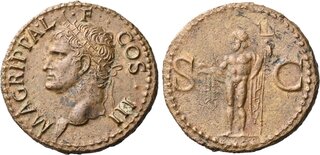| Numismatica Ars Classica > Auction 144 with CNG & NGSA | Auction date: 8 May 2024 |
| Lot number: 1014 Price realized: This lot is for sale in an upcoming auction - Bid on this lot  | Show similar lots on CoinArchives Find similar lots in upcoming auctions on |
| Lot description: The Geoffrey Cope Collection of Ancient Greek and Roman Bronzes. The Roman Empire. Divus Augustus, in the name of Agrippa. Description As, Roma after 37, Æ 29 mm, 11.14 g. M AGRIPPA L – F COS III Head l., wearing rostral crown. Rev. S – C Neptune, cloaked, standing l. holding small dolphin and trident. Reference C 3 BMC Tiberius 161 RIC Gaius 58 CBN Gaius 78 Condition A bold portrait of fine style with a superb light brown tone. Reverse from a worn die, otherwise extremely fine Whereas Roman imperial aes coinage was previously struck at Lugdunum Caligula is thought to have minted in Rome around 37-38. This impressive as belongs to the emperor's new Rome mint coinage, which placed a great deal of importance on emphasising Caligula's legitimacy through his descent. Here, the types and legends honour Caligula's maternal grandfather, M. Vipsanius Agrippa, a man who had famously served as Octavian's lieutenant during the conflict with Mark Antony and Cleopatra, and who won the critical naval victory at Actium (31 BC) that sealed the fate of Octavian's enemies. Not only was Agrippa a key figure in Octavian's rise to power and transformation into Augustus, the first Roman emperor, but he was named as the intended imperial successor in 23 BC. Unfortunately, as it turned out, Agrippa was a poor choice of heir. He died at the age of 50 in 12 BC and was long outlived by Augustus. Agrippa is celebrated on this coin for his greatest achievement-the defeat of Antony and Cleopatra at Actium. His portrait is shown wearing the rostral crown, a wreath composed of joined representations of prows (rostra in Latin) taken from captured war galleys. Such crowns were awarded to victorious naval commanders under the Roman Republic. The first rostral crown is said to have been awarded during the First Punic War to a certain Attilius, who may be C. Atilius Seranus, who won a victory at Mylae in 260 BC; M. Atilius Regulus, who won a victory at Economus in 256 BC; or A. Atilius Calatinus for one of his Sicilian victories in 258-257 BC. The award of this type of crown to Agrippa is often seen as part of Augustus' conscious program of reviving Republican traditions to obscure his assumption of monarchical authority. The rostral crown soon became a standard feature of Agrippa's iconography. The reverse type depicting Neptune builds on the rostral crown of the obverse, but subtly comparing Agrippa to the Roman god of the sea. Such juxtaposition of a victorious naval commander with the image of maritime gods has a fairly long tradition in numismatic art and can be traced back to the Hellenistic coinages of Demetrios Poliorcetes. Estimate: 1500 CHF |  |



